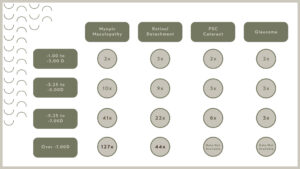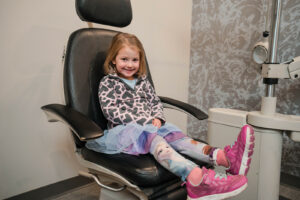Myopia Management
What is Myopia?
Myopia (or nearsightedness) is a common condition which causes blurry distance vision. Myopia is shown in eyeglasses prescriptions as a number written with a minus sign. It is the most common cause of impaired vision for those under the age of 40. Myopia often begins in childhood and can quickly increase to higher degrees if left unmanaged. Unfortunately, the rate at which people are becoming Myopic is increasing at a rapid rate, from 25% of the population in the year 2000 to research showing an expected 50% will be Myopic by 2050
(Holden B.A., Fricke T.R., Wilson D.A, Jong M., Naldo K.S., Sankaridurg P., Wong T.Y., Naduvilath T.J., Resniko S. Global Prevalence of Myopia and High Myopia and Temporal Trends from 2000 through 2050. American Academy of Ophthalmology. 05/2016, vol.123, no. 5, p.1036-1042. Https://doi.org/10.1016/j.Ophtha.2016.01.006)
What causes Myopia?
Myopia happens when light rays enter the eye and are focused in front of the retina instead of on the retina. This is what causes the blurry distance vision. This is caused by the length of the eye and the shape of your cornea.
Our Optometrists will evaluate your children’s vision for any refractive error (Myopia) as well as measuring the length of the eye (Axial Length) and do an overall ocular health check to assess if they are a candidate for our Myopia Management Program.
Why is Myopia Management important?
Those with myopia often experience symptoms such as headaches, squinting, eye strain, and difficulty with activities that require good distance vision like school and sports. Children with Myopia often struggle with their vision and learning at school. Myopia can be quite debilitating for people when it comes to simple daily tasks such as shaving, doing their makeup or even seeing the alarm clock.
The risk of myopia increases with more hours of nearwork including reading and devices and with less hours spent outdoors. Having one or both parents being nearsighted also increases the likelihood of a child being myopic.
The younger a child is when they become myopic, the more they will progress to higher amounts of myopia. With higher amounts of myopia we see an increased risk of sight threatening complications including: myopic macular degeneration, retinal detachments, glaucoma and cataracts.
The chart below shows the increased risk of eye disease as myopia increases

Chart information received from HOYA Canada. More information available at: https://www.hoyavision.com/en-ca/vision-products/miyosmart/
Data sources: Gifford K. Preparing Your Practice for the Myopia Control Stampede. Contact Lens Spectrum, Volume: 31, issue: June 2016, page(s): 20-23, 25, 255.
WHO. The impact of myopia and high myopia. Report of the Joint World Health Organization-Brien Holden Vision Institute Global Scientific Meeting on Myopia, University of New South Wales, Sydney, Australia, 16-18 March 2015.
Flitcroft D.I. The complex interactions of retinal, optical and environmental factors in myopia aetiology. : Prog Retin Eye Res. 2012 Nov;31:622-660
Saw S., Gazzard G., Shih-Yen E., Chua W. Myopia and associated pathological Complications. Ophthal. Physiol. Opt 2005 25: 381-391.
Lai T. Retinal Complications of High Myopia. Meddical Bulletin. Vol.12No 9.09/2007
How do we manage Myopia?
Fortunately, more and more studies are showing that we are able to delay the onset of myopia and also slow down the progression of myopia with a number of different treatment options.
With more of our population becoming myopic we believe it is important to help the developing eyes of children to reduce the rate of myopia and lower the risk of vision complications later in life. Managing myopia with our Optometrists will include a therapeutic treatment approach that’s especially important before the age of 10 but is viable for all children.

Treatments include:
Myopia Control Glasses like the MiyoSmart lenses by Hoya. These specialized lenses are supported with extensive research in reducing the rate of myopia progression with an average reduction of 60%. This lens features Defocus Incorporated Multiple Segments (D.I.M.S.) technology to offer clear vision while a ring shaped treatment zone manages the light entering the back of the eye, shown to reduce the amount of myopia progression.
Myopia Control Contact Lenses may be an option for more active children in conjunction with glasses to continue managing myopia while not wearing their glasses. MiSight 1 day contact lenses feature an ActivControl Technology that helps slow the elongation of the eye and continue reducing myopia progression while still providing clear everyday vision.
Atropine eye drops may be used to help delay the onset of myopia or slow myopia progression however, it does not correct vision. This solution, while effective, usually requires another treatment modality such as glasses or contact lenses. The eye drop is instilled once daily, at night, and can cause headaches and light sensitivity.
Ortho-K lenses are rigid gas permeable lenses that are worn at night only and work by temporarily reshaping the cornea.
Lifestyle is also an important part of managing myopia. Studies show that children should be spending about 2 hours outdoors everyday to reduce the risk of myopia progression. It is also very important to take frequent breaks from near work as long periods of time working up close with books, computers, and phones may affect the development of myopia.
How do I discover if myopia management is an option for my child?
With an eye exam for your children! Our Optometrists will see children as young as newborns and Alberta Health Care covers the cost of your child’s eye exam until they turn 19 years of age. Click here to request an appointment online.
Book Your Appointment Online
